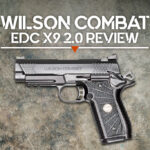

Guest Writer: Kenzie Fitzpatrick
We never get tired of watching movies, but we often watch scenes play out that aren’t realistic. Their approach is believable, but the way they go about solving problems defies logic, engineering, and sometimes physics. Take deadbolt locks as an example. When a character shoots a deadbolt lock, it disintegrates and the door busts wide open. It looks good on screen, but what happens when you shoot a deadbolt in real life?
That’s the question we set out to answer with this project: Whether the action we’re presented with on the big screen has any authenticity to it. We wanted to find out what really happens when you shoot a deadbolt with various calibers to see if Hollywood did their homework.
Testing Goals
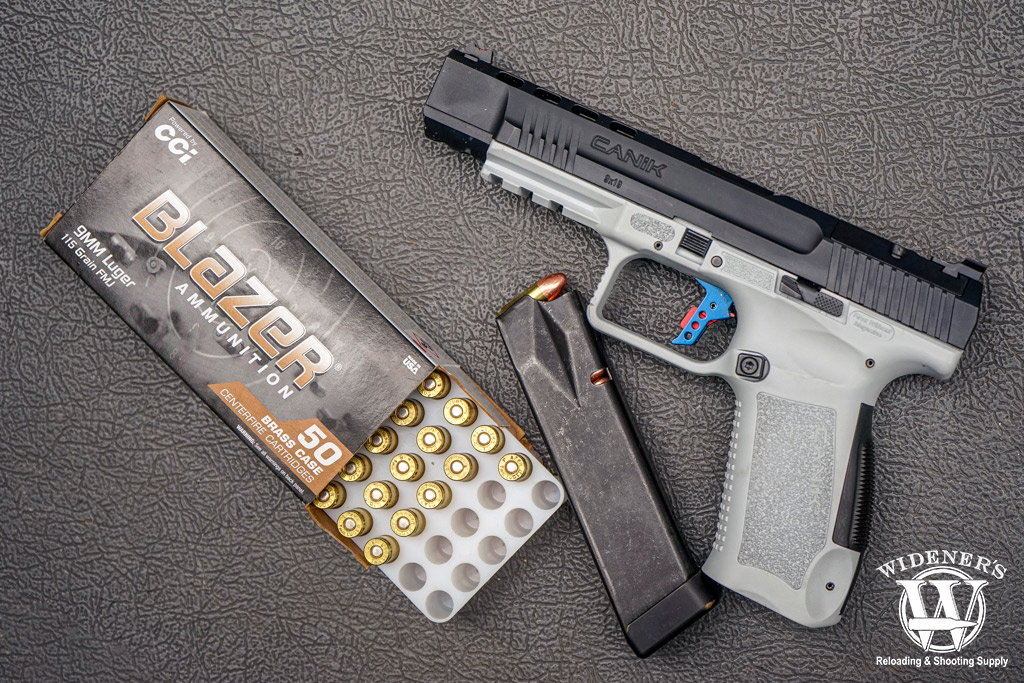
For our testing, we decided to stick with common calibers, 9mm, 5.56, and 12-Gauge 00 buckshot.
We’ve seen pistols, shotguns, and even rifles used in shooting a deadbolt from doors in movies and on TV. So that’s where we decided to start. We built a sturdy frame out of 4×4 lumber and cemented the posts 24″ into the ground. The 4×4 posts were leveled as well as the door frame to give the project the best chance of success. We experimented with shooting the deadbolts on two different types of doors, with four different guns. Looking to see if, in true Hollywood style, the locks failed and the doors swung open or not.
While doing research for the project, we also found internet stories of kids shooting deadbolt locks with pellet guns. In some instances, it was just bored kids causing mischief. However, one published account reported that a group of teens burglarized several upscale homes. These teens gained access by shooting deadbolt locks with a pellet gun. Although that sounded farfetched, we were nonetheless curious. So we decided to include the pellet gun in our test.
Is the shooting deadbolts open in movies purely movie magic? Or is there a real-world transfer of energy that can make this happen? In considering guns you must account for the size, grain weight, and velocity of the bullet. Additionally, when including the shotgun, we had to factor in the number and size of the projectiles. For our testing purposes, we decided to go with the most common options found on the civilian market. You’ll find our selections listed in the section below.
Shooting A Deadbolt: Testing Procedures
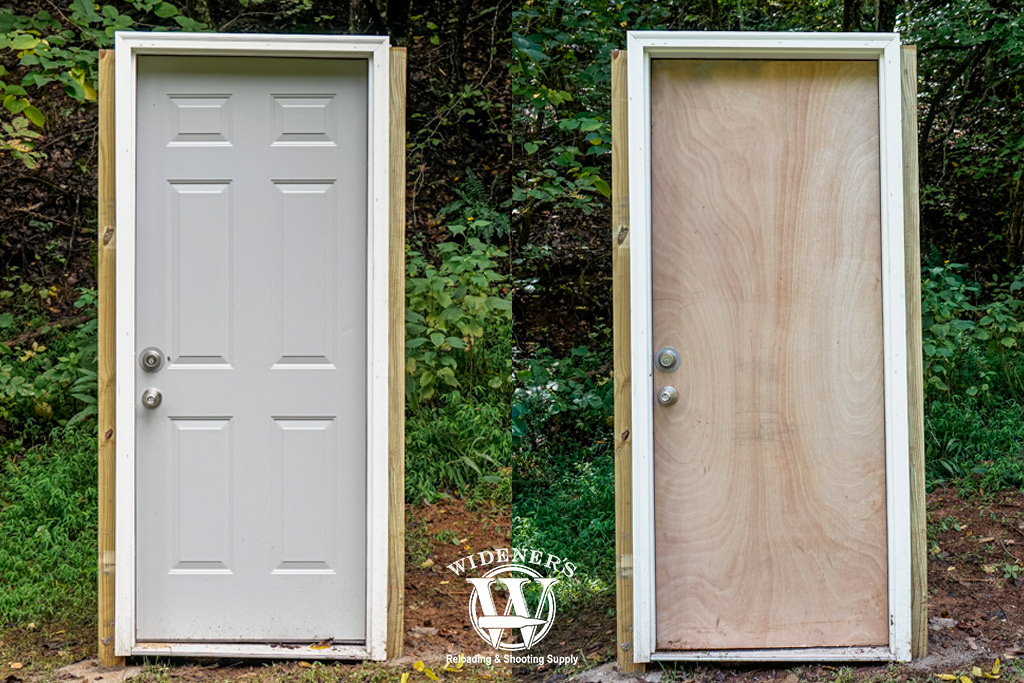
Ladies and gentlemen, the doors: A 65-Lbs steel door with fiberglass interior (left), and a 15o-Lbs solid wood door (right).
For testing, we chose the most common calibers most Americans own and use. Also, these are most commonly portrayed the most in movies and TV shows. We used a .177 pellet gun, a 9mm pistol, a rifle chambered in 5.56, and a 12 gauge shotgun.
Ammunition Used For Our Testing:
- Premier 7.5 grain, .177 caliber pointed pellets
- Blazer Brass 9mm 115gr FMJ
- Winchester 5.56 55gr FMJ
- Federal 12-Gauge, 00 Buck, 9 Pellet, 2-3/4″ Shotgun Shells
For deadbolts, we tested the Kwikset Security 600 Series locks that you can buy at any local hardware store. The two standard exterior doors included a basic solid wood door, and a steel door with a fiberglass interior. We shot these deadbolts from about 10 yards away from the doors for safety reasons, with enough velocity to replicate mostly what we see on TV.
Deadbolt Security
Deadbolt locks function by rotating the lock cylinder with a key, forcing the bolt of the lock into a recess in the door frame. The idea is that the bolt creates greater resistance to entry than a traditional doorknob lock. There are single-cylinder and double-cylinder deadbolts, both options offer a variety of security features and are operated by a key. Other deadbolt options include push button operation, thumb turn operation, and exit-only options with no external cylinder.
Generally, the American National Standards Institute (ANSI) rating system is used to measure the level of security for deadbolt locks. This rating system works on a numerical scale measuring security grades 1-3. On the ANSI scale, security grade 3 is considered the lowest level of security, while security grade 1 is considered the highest level of security. The Kwikset Security 600 Series locks we used for our testing are rated ANSI grade 3, which is common for residential locks.
Shooting A Deadbolt: Mythbusted?
With the exception of the pellet gun test, we used a fresh deadbolt for each caliber gun and each door type. Each time we shot a different caliber, we examined the front and back of the deadbolt, and the front and back of the door to see the damage done. With each caliber, we tested whether or not the key still fit into the hole to turn the deadbolt. If the key didn’t fit, we checked to see if the deadbolt was still intact inside the door frame. We also turned the doorknob between each caliber to check to see if the door had swung open at all or remained shut. The results? You might be as surprised as we were to find out!
Pellet Gun .177
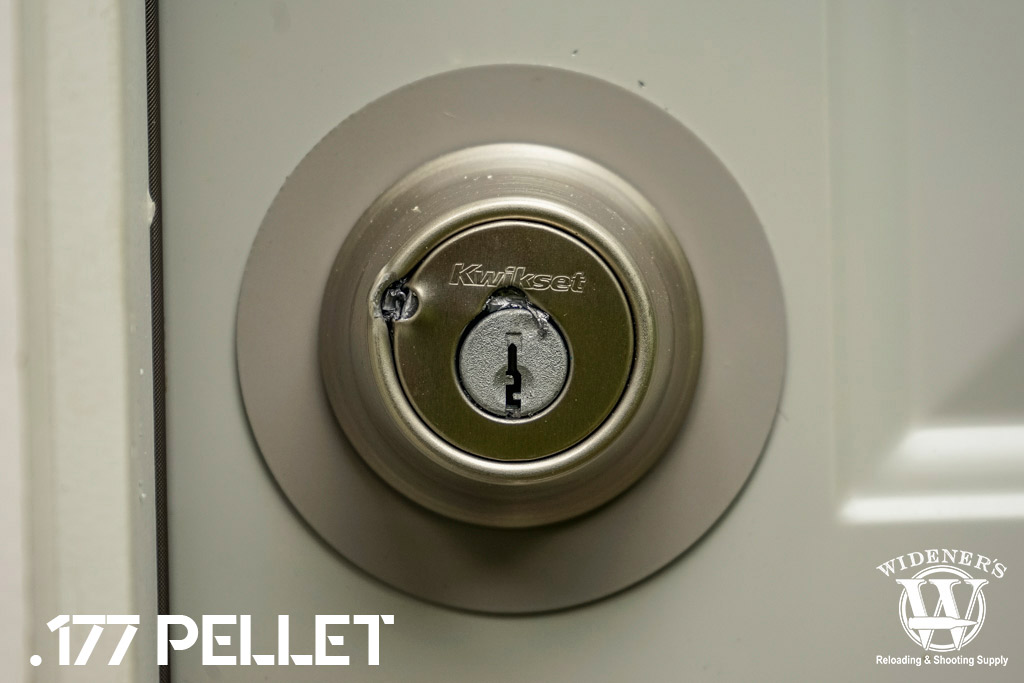
While the .177 pellet did penetrate the deadbolt’s faceplate, it didn’t do enough damage to disrupt the lock.
| Door Type | Bullet Weight | Velocity | Penetration | Deadbolt |
|---|---|---|---|---|
| Steel Door | 7.5gr | 1300 FPS | 1/16″ (Faceplate) | Functional, Locked |
| Wood Door | N/A | N/A | N/A | N/A |
The pellet gun by far caused the least amount of damage to the deadbolt lock. The pellets did in fact penetrate the faceplate cover of the deadbolt. But they were ultimately too soft to do any further damage. After being shot with the pellets, the lock still allowed us to insert the key and easily turn the deadbolt left and right. This was a total myth busted and proved that a pellet gun won’t destroy a deadbolt lock, cause it to fail, or blow open a door.
9MM 115gr FMJ
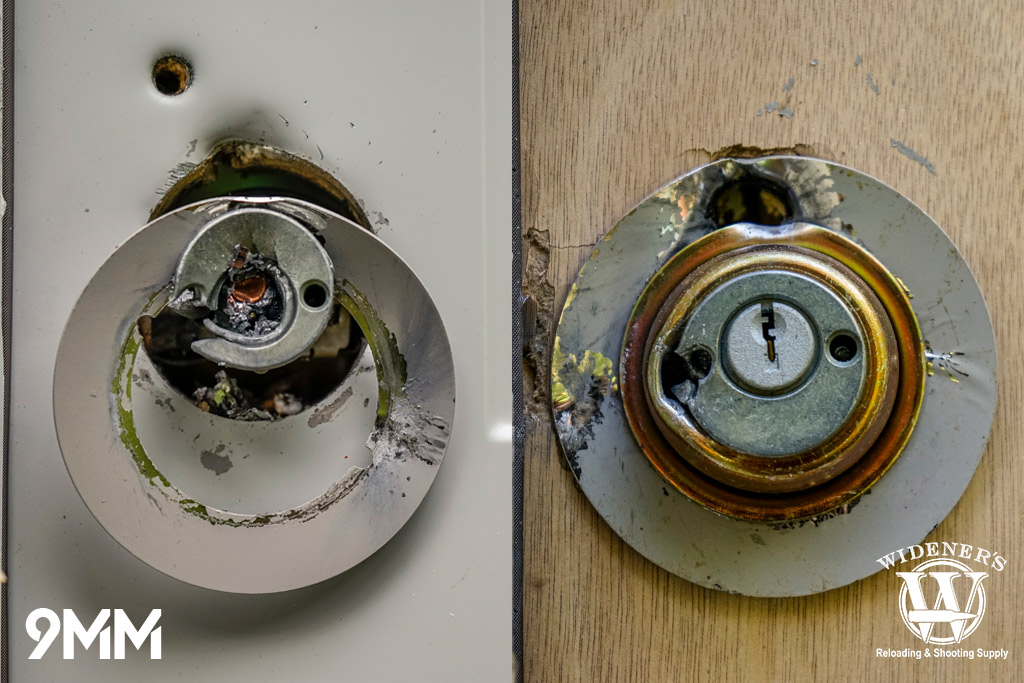
The 9mm 115gr bullet did serious damage to the deadbolt locks. However, both doors remained securely locked.
| Door Type | Bullet Weight | Velocity | Penetration | Deadbolt |
|---|---|---|---|---|
| Steel Door | 115gr | 1180 FPS | 2+” (Faceplate) | N0n-Functional, Locked |
| Wood Door | 115gr | 1180 FPS | 2+” (Faceplate) | N0n-Functional, Locked |
On the steel door, it took several shots with the 9MM to cause the locking cylinder to fail. The keyhole was destroyed on the last shot, so there was no way to test the lock’s functionality. The damage to the door was also minimal, with the rear exit holes being only slightly larger than the entry holes. The door did not blow open as we’ve seen in movies, and in fact, after five shots, the deadbolt remained firmly locked in place.
On the wooden door, the first shot hit the bolt, freezing it in place. The second shot passed through the faceplate of the deadbolt, disrupting the cylinders. The key would go into the front of the lock, but it turned endlessly in either direction rendering it non-functional. It continued to keep the door locked securely, even after it took a direct hit. The wood door took more damage than the steel door, however, like the steel door, it did not blow open at all.
Shooting A Deadbolt: 5.56 55gr FMJ
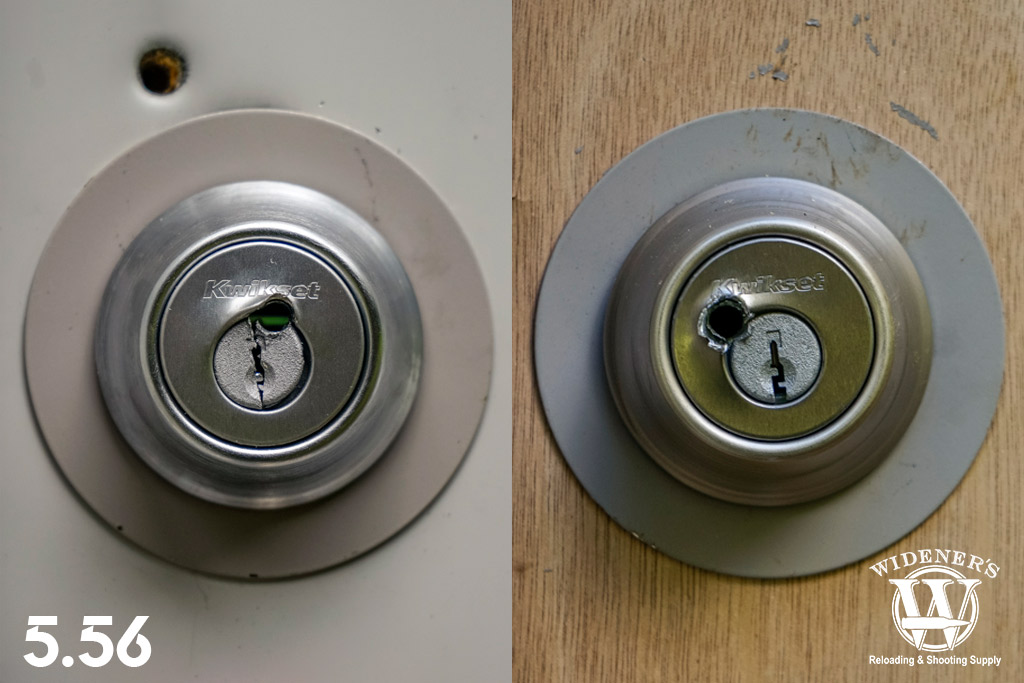
The 5.56 rounds smoked straight through the deadbolt locks but failed to cause them to come open.
| Door Type | Bullet Weight | Velocity | Penetration | Deadbolt |
|---|---|---|---|---|
| Steel Door | 55gr | 3240 FPS | 2+” (Faceplate) | N0n-Functional, Locked |
| Wood Door | 55gr | 3240 FPS | 2+” (Faceplate) | N0n-Functional, Locked |
One shot to the center of the steel door’s deadbolt completely shattered the locking mechanisms inside of the faceplate. The impact of the 5.56 round was devastating. The key was not able to be inserted into the lock, and the bullet looks like it moved upward upon impact and blew out the back of the door above the lock. The knob on the back of the door wouldn’t move left or right and the deadbolt was still tightly locked, holding the door shut.
On the wooden door, the shot passed right through the faceplate of the deadbolt. It hit the back cylinder of the deadbolt and folded it like a stack of soggy pancakes. The bullet traveled upwards after making contact and the damage to the door was minimal. We could insert the key, but the deadbolt would barely move left or right, so the door remained firmly locked. The myth that a 5.56 rifle can blow open a locked door is seriously busted.
Buckshot: 12 Gauge 9 Pellet
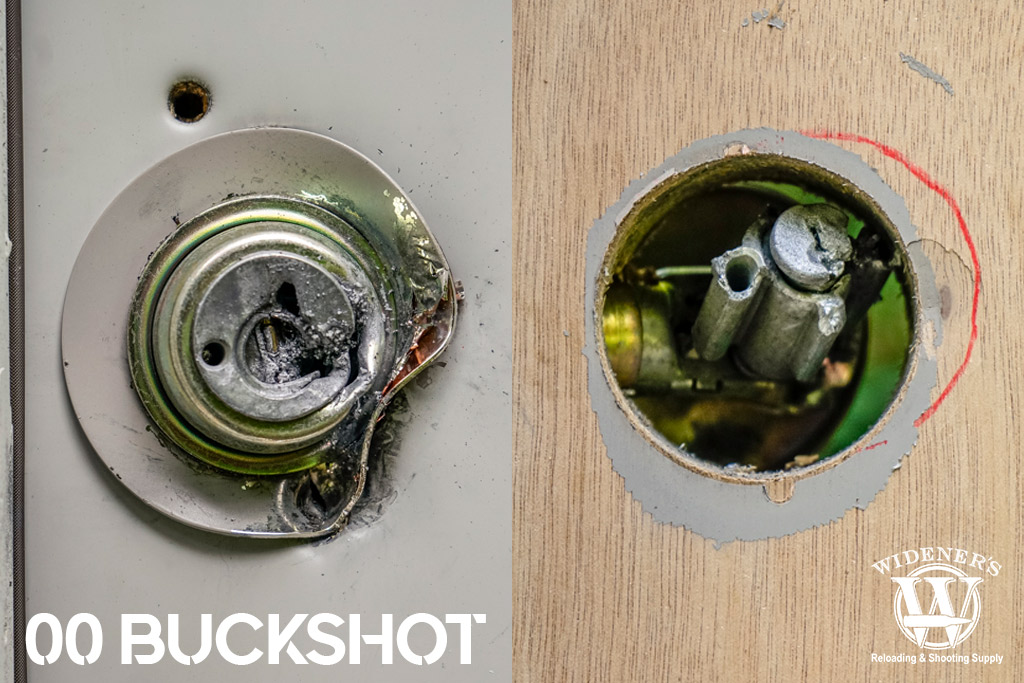
There’s no question that 00 buckshot causes the most damage to the deadbolts. Despite the damage, they remained in place and held the doors shut.
| Door Type | Bullet Weight | Velocity | Penetration | Deadbolt |
|---|---|---|---|---|
| Steel Door | 58.3gr (9-Pellet) | 1145 FPS | 2+” (Faceplate) | N0n-Functional, Locked |
| Wood Door | 58.3gr (9-Pellet) | 1145 FPS | 2+” (Faceplate) | N0n-Functional, Locked |
The 9-pellet buckshot seemed to do more damage than the pistol or rifle. On the steel door, the faceplate blew off the front, it also removed the locking knob on the back of the door, and the key wouldn’t go in the lock. The damage to the door was more noticeable, with a large exit cavity in the rear. That being said, even after taking 9 pellets of 00 buckshot, the deadbolt didn’t fail, and the door remained closed.
Shooting the wooden door was similar. There was nothing left on the front of the lock, the back of the wooden door around the lock was blown out, and the knob was locked into place. The back of the door looked splintered and you could see daylight through it. The deadbolt was non-functional but was still securely locked, and the door never swung open when shot. Myth totally busted.
Alternative Ways To Open A Door
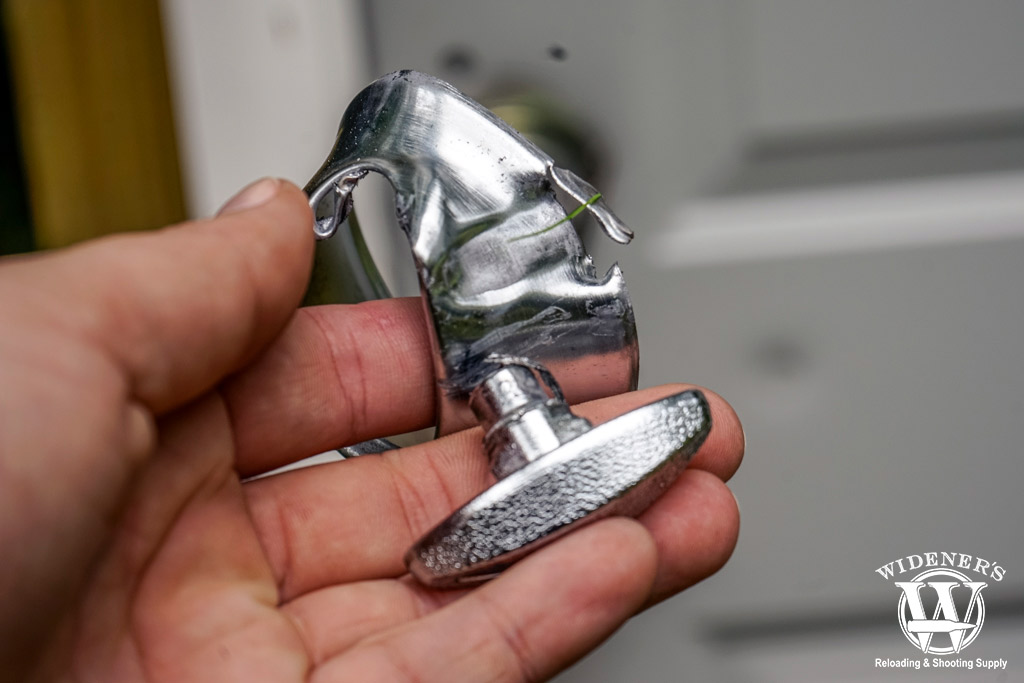
Deadbolt locks can take a serious beating. We were surprised by how well the grade 3 residential locks held up to being shot at.
Why Not Shoot The Deadbolt Multiple Times?
Our goal when shooting the deadbolts was to disrupt (or remove) tumblers inside of the lock. In theory, if we were able to accomplish this, causing the deadbolt to fail, the doors should have swung open. With certain calibers like 5.56, we were able to accomplish that with a single shot. With other calibers, like 9mm, we needed to shoot the lock multiple times to accomplish the required disruption.
We noticed that despite taking several direct hits from the 9mm, there were no major internal failures in the deadbolt that would allow the door to swing open. Even with the high velocity of the rifle ammunition, the penetration of the round still doesn’t have enough force to blow out the lock. A shotgun seemed to do the most damage. In fact, in our video above, you can see that the deadbolt still remains locked and the door closed even when blasted with buckshot.
Over time, you could absolutely shoot the deadbolt out of the door with any of the calibers we tested. However, dumping two, or three magazines of 9MM into the deadbolt defeats the purpose of our testing. There’s a difference between brute force and precision shooting. Also, each time you shoot the lock, you’re increasing your chances of getting hit with shrapnel or a ricochet. What we learned is that if someone needed to open a locked door, shooting the deadbolt out of it would be a very inefficient way to gain entry.
Why Not Shoot The Bolt Out Through The Door?
For starters, it’s not that easy to hit it. The bolt itself is only about an inch tall, making it a very small target even from a few feet away. If you do hit it, it’s going to take multiple shots to cause it to fail, and even more shots to cause the door behind it to fail. We learned that shooting the cylinder from the front doesn’t do much beyond locking up the deadbolt even more. After the bolt locked up, it was next to impossible to remove the old bolt and lock and replace it with a new one.
Shooting the deadbolt through the metal door most likely give similar results as the metal is penetrable, but still sturdy enough to remain mostly intact. We also noticed that the bullet holes going into the lock didn’t come out of the back of the lock in a straight line. One bullet expanded on impact and stayed in the front of the faceplate. The rifle bullet deflected and moved upward at an angle, out the back. Pellets from the buckshot flattened and shrapnel was on the ground by the door, no telling where they came out of. So even if you shot the bolt through the door, that shot isn’t going to split the deadbolt in half or force it through the door frame.
Why Not Use Breaching Rounds?
Breaching shotshells fire a load of metal powder with the intent of forcing a lock or hinge to fail. They are meant to be used at extremely close range (often with the barrel touching the target) and designed to reduce shrapnel or ricochets. The industry joke for the reason breaching rounds exist is that it takes two people to operate a battering ram. While that’s not entirely true, these rounds are most commonly used by police and military for breaching in close quarters. These specialty shells, sometimes called “master keys,” require a shotgun with a muzzle standoff to allow propellant gasses to escape.
There are currently no federal laws against civilians owning breaching rounds. However, some breaching rounds are not commercially available to civilians. Breaching rounds are also more of a modern invention, for decades, the police and military used 00 buckshot for door breaching. For these reasons, we decided to stick to standard ammo types that are widely available for our testing.
Why Not Kick In The Door?
We’ve all seen doors kicked in and police TV shows showing battering rams being used. However, in real life, it’s not so easy to kick in a door. Some people will not have the body weight and force to be able to kick in a solid door with a good deadbolt. Also, one of the most dangerous places to be is on the other side of the door if there’s a criminal on the other side with a loaded gun. Being able to “shoot out” a door from a distance can be a safer alternative than spending time up close trying to kick it in when most doors are penetrable in some capacity.
With all the movies we’ve seen, we’ve seen some epic door kicking, but ten times the amount of doors being shot and busted open with heavy firepower. We wanted to test the myth to see if a gun is all you need to break a door wide open or if that Hollywood movie magic is at it again.
Deadbolt Buying Guide
As we discovered in our testing, even the lowest rated ANSI security deadbolts can take a beating. However, stopping bullets is one thing, and stopping a skilled lock pick is another. High-security deadbolts may cost more, but they have additional features to protect your home and valuables from intruders. So what should you look for when buying a high-security deadbolt?
- Grade 1 – Commercial, key required, anti-pick lock security or protection against bumping attacks, rated 800,000 cycles
- Grade 2 – Residential, key required, no anti-pick lock security or protection bumping attacks, rated 600,000 cycles
- Grade 3 – Residential, key required, no anti-pick lock security or protection bumping attacks, rated 100,000 cycles
Be sure to look at a lock’s ANSI security rating before making a purchasing decision. Depending on what you are locking up, a ANSI grade 3 lock may be more than enough security for you. Those living in apartments likely already have an ANSI grade 2 lock and deadbolt installed. Their rating meets most apartment building security requirements. If you own a business or are storing valuable data at a remote location, installing an ANSI grade 1 lock may help you sleep better at night.
Shooting A Deadbolt: Fact VS Fiction
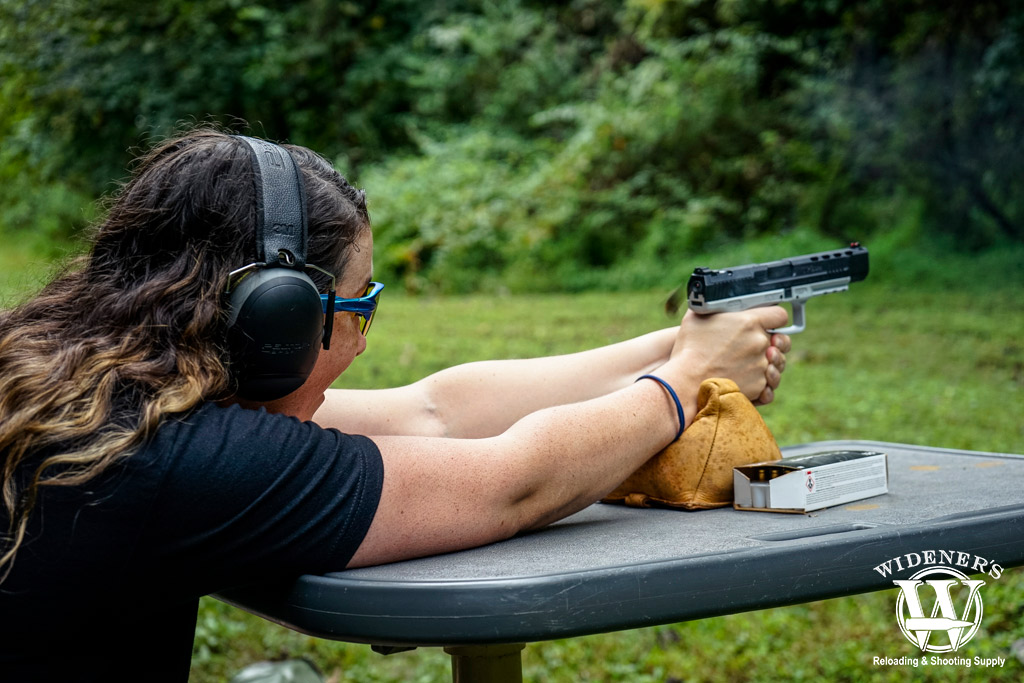
Mythbusted? Absolutely, there’s no easy way to shoot a deadbolt out of a steel, or wooden door.
We can confidently say “myth-busted” on shooting a deadbolt the way it’s depicted in movies. We tried two different doors, and a series of level 3 residential security deadbolts to confirm our conclusion. The only gun that really came close to blowing a door open was the shotgun. As a whole, this myth is totally busted. It didn’t matter what caliber, grain weight, velocity, or which gun the ammo came out of. No doors flew open when the deadbolts were shot. Even at a close distance, we thought we’d see some door movement, but unfortunately, all we found was Hollywood smoke and mirrors.


